- 코로나19 바이러스의 위험성이 과장되었다고 보십니까? - Gallup International 다국가 조사
- 조사일 : 2023/12/15
- [GallupReport(20240415)_Covid19_GIA.pdf] 다운로드
● 2024년 4월 15일(월) 공개 | 문의: 02-3702-2571/2621/2622
코로나19 바이러스의 위험성이 과장되었다고 보십니까?:
Gallup International 다국가 조사
→ 한국+세계 조사 결과 파일 다운로드(PDF)
/ 세계 조사 개요
· 2023년 10~12월 44개국 성인 총 43,922명 전화/온라인/면접조사(주제별 참여국 상이)
/ 한국 조사 개요
· 조사기간: 2023년 11월 2일~12월 4일
· 표본추출: 층화 집락 확률 비례 추출
· 응답방식: 면접조사원 인터뷰(CAPI)
· 조사대상: 전국(제주 제외) 만 19세 이상 1,550명
· 표본오차: ±2.5%포인트(95% 신뢰수준)
· 응답률: 29.8%(총 접촉 5,196명 중 1,550명 응답 완료)
· 의뢰처: 한국갤럽-Gallup International 자체 조사
조사 결과
────────────
'코로나19 바이러스의 위험성이 과장되었다'
────────────
44개국 성인 중 45% 동의, 비동의 33%, 중립+의견유보 21%
- 동의율 상위국: 보스니아헤르체고비나(75%), 코소보(71%), 아제르바이잔(68%)...
- 비동의율 상위국: 스페인(61%), 멕시코(57%), 스웨덴(55%), 영국(49%), 독일(48%)...
2023년 10~12월 갤럽 인터내셔널이 세계 44개국 성인 43,922명에게 '코로나19 바이러스의 위험성이 과장되었다'라는 주장에 어느 정도 동의하는지 물었다. 그 결과 45%가 동의했고(5점 척도 중 '매우 동의한다'+'동의하는 편', 이하 '동의율'), 33%는 동의하지 않았다. 18%는 중립('어느 쪽도 아니다'), 3%는 의견을 유보했다.
◎ 코로나19 위험성 과장 주장 동의율이 높은 나라는 보스니아헤르체고비나(75%), 코소보(71%), 아제르바이잔(68%), 루마니아(66%), 조지아(65%) 순인데, 이들 동유럽·동남유럽 국가들은 지난 코로나19 팬데믹 기간 중 사망자가 많았던 곳이라는 점이 다소 아이러니하다. 팬데믹 기간 중 희생자가 많았던 아프리카 대륙에서는 국가 간 인식 차가 큰 편이다. 케냐에서는 59%, 나이지리아에서는 32%만 코로나19의 위험성이 과장됐다고 봤다.
한편, 무력 분쟁이나 전쟁 때문에 생사를 위협받는 아프가니스탄(62%), 이라크(59%), 시리아(57%) 등에서도 코로나19 위험성 과장 주장 동의율이 44개국 평균을 웃돈다. G7/EU 국가들의 동의율은 38%(:비동의 41%)로, 그 외 국가들의 49%(:30%)보다 낮다.
◎ 코로나19 위험성 과장 주장 비동의율이 높은 나라는 스페인(61%), 멕시코(57%), 스웨덴(55%), 영국(49%), 독일(48%), 미국, 캐나다(이상 47%), 포르투갈(46%) 순이다. 이들 나라들은 대체로 인구가 많고, 팬데믹 당시 높은 사망률과 많은 확진자를 기록했다.
◎ WHO(세계보건기구)는 2020년 1월 30일 코로나19 비상사태를 선포했고, 2023년 5월 6일 WHO(세계보건기구)가 해제를 선언했다. 팬데믹 기간 중 나라마다 확산 속도와 사망자 추이, 정부 대응에 차이가 있었다. 그에 따라 각국 시민의 위험성 인식 양상 또한 달랐고, 여전히 그 영향력이 이어지고 있는 듯하다. 2024년 3월 말 기준 전 세계의 코로나19 확진자 수(약 7.7억 명)는 전 인구(약 81억 명)의 10% 미만, 감염자의 약 1%가 사망한 것으로 보고됐다(→ WHO COVID-19 dashboard).
◎ 한국 조사는 2023년 11월 2일~12월 4일 전국(제주 제외) 만 19세 이상 1,550명을 대상으로 했다. 한국인 중에서는 28%가 코로나19 위험성이 과장됐다는 데 동의했고, 39%는 동의하지 않았다(중립 33%, 의견유보 2%). 조사 참여국 중 스웨덴·스페인(25%) 다음으로 코로나19 위험성 과장 주장 동의율이 낮지만, 그 두 나라만큼 강한 반대 표명은 하지 않았다. 코로나19 위험성이 과장되지 않았다는 믿음은 60대 이상 여성(50%)에게서 가장 두드러졌다. 이는 고령자 치명률이 높은 코로나19 특성을 반영한다.
◎ 참고로, 코로나19 감염 우려감(4점 척도 중 '(매우+어느 정도) 걱정된다' 응답 비율)은 2020년 8~12월(2~3차 확산기) 80% 내외, 2021년 2월(국내 백신 도입 직전)인 73%, 2022년 3월(3차 백신 접종 시행, 오미크론 변이 우세종화, 확진자 급증) 58%, 2023년 3월 39%로 감소했다. 2023년 3월 말 기준 국내 누적 확진자는 3천여 만 명, 한국인 열에 여섯 명꼴이었다. 당시는 대부분의 방역 조치가 해제된 상황에서 하루 1만 명 안팎의 신규 확진자가 발생했고, 60대 이상에서의 감염 우려감이 61%(:20대 27%)로 높았다(→ 데일리 제536호).
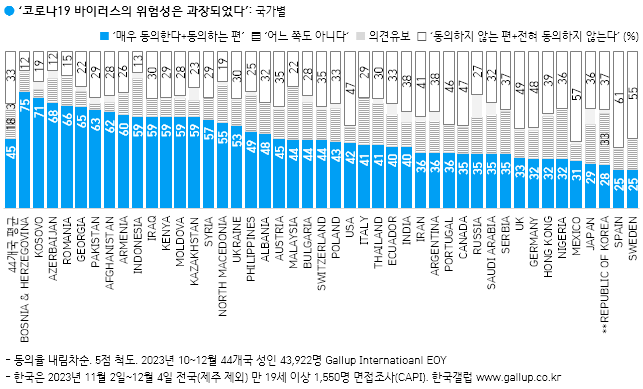
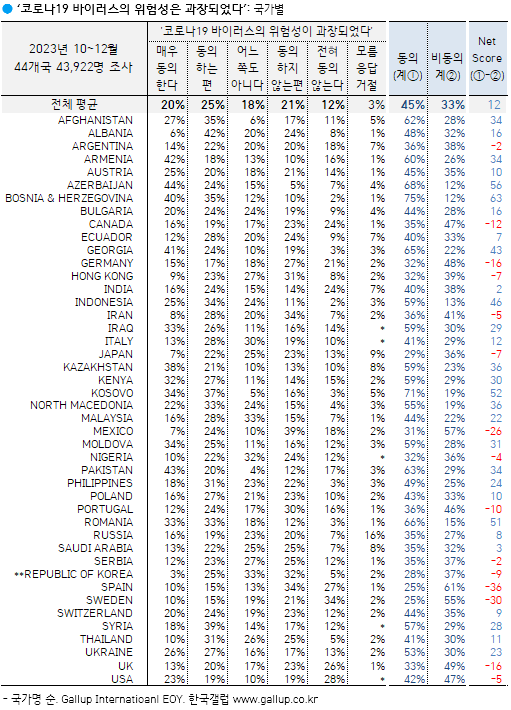
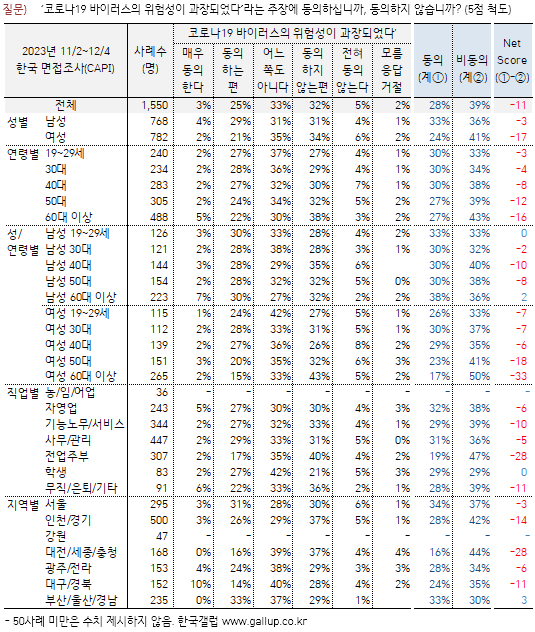
──────────────────
The world is divided in belief
that the threat from COVID-19 was exaggerated.
──────────────────
A traditional End of Year GIA poll, conducted between October and December 2023 covering 44 countries globally, finds the world is divided in belief that the threat from COVID-19 was exaggerated.
Data shows 45% of survey respondents agree or strongly agree with the statement ‘I believe the threat from the Coronavirus was exaggerated’, compared to 33% who disagree or strongly disagree, and further 18% who lean in neither direction.
When interrogating the global data, significant differences are found within and between global regions.
Despite having some of the highest reported deaths , countries in Eastern and Southeastern Europe are the most likely to agree the threat was exaggerated – Bosnia and Herzegovina (75%), Kosovo (71%), Azerbaijan (68%), Romania (66%) and Georgia (65%) among the most likely.
Previous research indicates that countries across Europe have suffered a significant decrease in perceptions of vaccines as ‘important’ post-pandemic , building on the narrative that the seriousness of public health is being de-emphasized across the region.
Previous research also points to negative perceptions of the national government from people in this region, with a majority having experienced their government to be a dividing force during the COVID-19 pandemic . With governments spearheading the COVID-19 pandemic response, impaired trust may be impacting public perceptions about the seriousness of the COVID-19 threat.
The Middle East (47%) also show high levels of agreement that the threat from COVID-19 was exaggerated. War torn countries – Afghanistan (62%), Iraq (59%) and Syria (57%), where there is a significant threat to life – are the most likely countries in the region to agree the threat was exaggerated.
Significant differences exist between countries surveyed in Africa, with agreement as high as 59% in Kenya while only 32% in Nigeria. Previous research highlights countries in Africa were huge targets of mis/disinformation campaigns about the COVID-19 pandemic. In 2022, 3 in 10 (28%) people across 7 countries in Africa (including Kenya and Nigeria) believed rumors the pandemic was a planned event by foreign actors , likely influencing levels of perceived exaggeration.
The same research also points to threats that were considered more poignant at the time of the COVID-19 pandemic, such as Malaria and lack of access to food and clear water. Like findings from the Middle East, where other significant threats exist, countries appear more likely to agree the threat from COVID-19 was exaggerated.
Lastly, countries in Western Europe, North America and Latin America are the most likely to disagree that the threat from COVID-19 was exaggerated. Spain (61%), Mexico (57%), UK (49%), Germany (48%), USA (47%), Canada (47%) and Portugal (46%) are the highest. All of these largely populous countries suffered a high death rate and a large volume of confirmed cases . With so many people being exposed to the devastating impacts of COVID-19, it is no wonder they are less likely to believe the threat was exaggerated.
Kancho Stoychev,
President of Gallup International Association:
“The first global shutdown in human history implemented after the spread of the COVID virus in 2019 still divides the public opinion. Four years later the total number of confirmed cases is seven hundred million or less than 10% of the global population and the total death toll accredited to that disease is seven million or one percent of all registered infected. The official global death rate per thousand statistics do not show peak levels in 2020 and 2021 /7.612 and 7.645 respectively/ compared to 10 years ago (2011 – 7.818 and 2023 – 7.711). Nevertheless, a majority in most of the developed world still believes that the dangers from COVID-19 are not exaggerated, while in the vast part of the other world a majority believes the opposite. Why? Most probably the answer is related to the power of media and propaganda in the Western world.”
───
한국 응답자 특성표
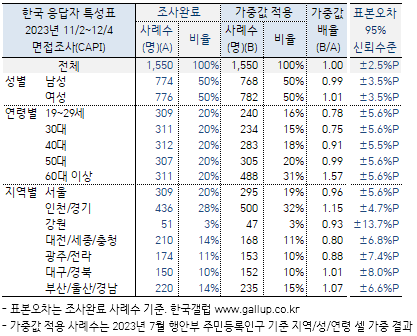
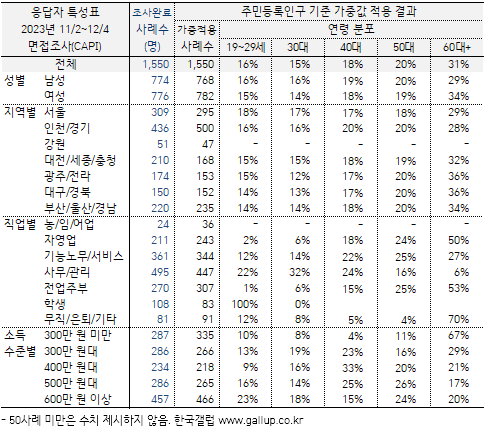
| ● 1947년 조지 갤럽 박사가 설립한 갤럽 인터내셔널(Gallup International Association)은 1977년부터 전 세계 회원사들이 매년 말 자국민을 대상으로 경제, 노동, 국제 관계 등 현안에 대한 인식과 새해 전망을 알아보는 〈End of Year Survey〉를 해왔습니다. → Press release for the 120th Anniversary of Dr. George Gallup ● 한국갤럽은 1979년부터 45년간 이 조사에 참여하며, 매년 상반기 몇 차례에 걸쳐 그 결과를 전합니다. 앞서 공개한 〈새해 전망과 핵무기 실사용 위험성〉 〈브릭스 확대〉 〈자국 연루 전쟁 발발 시 참전 의향〉 〈민주주의와 선거〉에 이어 오늘은 〈코로나19 위험성 관련 인식〉을 알려드립니다. |
코로나19 바이러스의 위험성이 과장되었다고 보십니까?:
Gallup International 다국가 조사
→ 한국+세계 조사 결과 파일 다운로드(PDF)
/ 세계 조사 개요
· 2023년 10~12월 44개국 성인 총 43,922명 전화/온라인/면접조사(주제별 참여국 상이)
/ 한국 조사 개요
· 조사기간: 2023년 11월 2일~12월 4일
· 표본추출: 층화 집락 확률 비례 추출
· 응답방식: 면접조사원 인터뷰(CAPI)
· 조사대상: 전국(제주 제외) 만 19세 이상 1,550명
· 표본오차: ±2.5%포인트(95% 신뢰수준)
· 응답률: 29.8%(총 접촉 5,196명 중 1,550명 응답 완료)
· 의뢰처: 한국갤럽-Gallup International 자체 조사
조사 결과
────────────
'코로나19 바이러스의 위험성이 과장되었다'
────────────
44개국 성인 중 45% 동의, 비동의 33%, 중립+의견유보 21%
- 동의율 상위국: 보스니아헤르체고비나(75%), 코소보(71%), 아제르바이잔(68%)...
- 비동의율 상위국: 스페인(61%), 멕시코(57%), 스웨덴(55%), 영국(49%), 독일(48%)...
2023년 10~12월 갤럽 인터내셔널이 세계 44개국 성인 43,922명에게 '코로나19 바이러스의 위험성이 과장되었다'라는 주장에 어느 정도 동의하는지 물었다. 그 결과 45%가 동의했고(5점 척도 중 '매우 동의한다'+'동의하는 편', 이하 '동의율'), 33%는 동의하지 않았다. 18%는 중립('어느 쪽도 아니다'), 3%는 의견을 유보했다.
◎ 코로나19 위험성 과장 주장 동의율이 높은 나라는 보스니아헤르체고비나(75%), 코소보(71%), 아제르바이잔(68%), 루마니아(66%), 조지아(65%) 순인데, 이들 동유럽·동남유럽 국가들은 지난 코로나19 팬데믹 기간 중 사망자가 많았던 곳이라는 점이 다소 아이러니하다. 팬데믹 기간 중 희생자가 많았던 아프리카 대륙에서는 국가 간 인식 차가 큰 편이다. 케냐에서는 59%, 나이지리아에서는 32%만 코로나19의 위험성이 과장됐다고 봤다.
한편, 무력 분쟁이나 전쟁 때문에 생사를 위협받는 아프가니스탄(62%), 이라크(59%), 시리아(57%) 등에서도 코로나19 위험성 과장 주장 동의율이 44개국 평균을 웃돈다. G7/EU 국가들의 동의율은 38%(:비동의 41%)로, 그 외 국가들의 49%(:30%)보다 낮다.
◎ 코로나19 위험성 과장 주장 비동의율이 높은 나라는 스페인(61%), 멕시코(57%), 스웨덴(55%), 영국(49%), 독일(48%), 미국, 캐나다(이상 47%), 포르투갈(46%) 순이다. 이들 나라들은 대체로 인구가 많고, 팬데믹 당시 높은 사망률과 많은 확진자를 기록했다.
◎ WHO(세계보건기구)는 2020년 1월 30일 코로나19 비상사태를 선포했고, 2023년 5월 6일 WHO(세계보건기구)가 해제를 선언했다. 팬데믹 기간 중 나라마다 확산 속도와 사망자 추이, 정부 대응에 차이가 있었다. 그에 따라 각국 시민의 위험성 인식 양상 또한 달랐고, 여전히 그 영향력이 이어지고 있는 듯하다. 2024년 3월 말 기준 전 세계의 코로나19 확진자 수(약 7.7억 명)는 전 인구(약 81억 명)의 10% 미만, 감염자의 약 1%가 사망한 것으로 보고됐다(→ WHO COVID-19 dashboard).
◎ 한국 조사는 2023년 11월 2일~12월 4일 전국(제주 제외) 만 19세 이상 1,550명을 대상으로 했다. 한국인 중에서는 28%가 코로나19 위험성이 과장됐다는 데 동의했고, 39%는 동의하지 않았다(중립 33%, 의견유보 2%). 조사 참여국 중 스웨덴·스페인(25%) 다음으로 코로나19 위험성 과장 주장 동의율이 낮지만, 그 두 나라만큼 강한 반대 표명은 하지 않았다. 코로나19 위험성이 과장되지 않았다는 믿음은 60대 이상 여성(50%)에게서 가장 두드러졌다. 이는 고령자 치명률이 높은 코로나19 특성을 반영한다.
◎ 참고로, 코로나19 감염 우려감(4점 척도 중 '(매우+어느 정도) 걱정된다' 응답 비율)은 2020년 8~12월(2~3차 확산기) 80% 내외, 2021년 2월(국내 백신 도입 직전)인 73%, 2022년 3월(3차 백신 접종 시행, 오미크론 변이 우세종화, 확진자 급증) 58%, 2023년 3월 39%로 감소했다. 2023년 3월 말 기준 국내 누적 확진자는 3천여 만 명, 한국인 열에 여섯 명꼴이었다. 당시는 대부분의 방역 조치가 해제된 상황에서 하루 1만 명 안팎의 신규 확진자가 발생했고, 60대 이상에서의 감염 우려감이 61%(:20대 27%)로 높았다(→ 데일리 제536호).



──────────────────
The world is divided in belief
that the threat from COVID-19 was exaggerated.
──────────────────
A traditional End of Year GIA poll, conducted between October and December 2023 covering 44 countries globally, finds the world is divided in belief that the threat from COVID-19 was exaggerated.
Data shows 45% of survey respondents agree or strongly agree with the statement ‘I believe the threat from the Coronavirus was exaggerated’, compared to 33% who disagree or strongly disagree, and further 18% who lean in neither direction.
When interrogating the global data, significant differences are found within and between global regions.
Despite having some of the highest reported deaths , countries in Eastern and Southeastern Europe are the most likely to agree the threat was exaggerated – Bosnia and Herzegovina (75%), Kosovo (71%), Azerbaijan (68%), Romania (66%) and Georgia (65%) among the most likely.
Previous research indicates that countries across Europe have suffered a significant decrease in perceptions of vaccines as ‘important’ post-pandemic , building on the narrative that the seriousness of public health is being de-emphasized across the region.
Previous research also points to negative perceptions of the national government from people in this region, with a majority having experienced their government to be a dividing force during the COVID-19 pandemic . With governments spearheading the COVID-19 pandemic response, impaired trust may be impacting public perceptions about the seriousness of the COVID-19 threat.
The Middle East (47%) also show high levels of agreement that the threat from COVID-19 was exaggerated. War torn countries – Afghanistan (62%), Iraq (59%) and Syria (57%), where there is a significant threat to life – are the most likely countries in the region to agree the threat was exaggerated.
Significant differences exist between countries surveyed in Africa, with agreement as high as 59% in Kenya while only 32% in Nigeria. Previous research highlights countries in Africa were huge targets of mis/disinformation campaigns about the COVID-19 pandemic. In 2022, 3 in 10 (28%) people across 7 countries in Africa (including Kenya and Nigeria) believed rumors the pandemic was a planned event by foreign actors , likely influencing levels of perceived exaggeration.
The same research also points to threats that were considered more poignant at the time of the COVID-19 pandemic, such as Malaria and lack of access to food and clear water. Like findings from the Middle East, where other significant threats exist, countries appear more likely to agree the threat from COVID-19 was exaggerated.
Lastly, countries in Western Europe, North America and Latin America are the most likely to disagree that the threat from COVID-19 was exaggerated. Spain (61%), Mexico (57%), UK (49%), Germany (48%), USA (47%), Canada (47%) and Portugal (46%) are the highest. All of these largely populous countries suffered a high death rate and a large volume of confirmed cases . With so many people being exposed to the devastating impacts of COVID-19, it is no wonder they are less likely to believe the threat was exaggerated.
Kancho Stoychev,
President of Gallup International Association:
“The first global shutdown in human history implemented after the spread of the COVID virus in 2019 still divides the public opinion. Four years later the total number of confirmed cases is seven hundred million or less than 10% of the global population and the total death toll accredited to that disease is seven million or one percent of all registered infected. The official global death rate per thousand statistics do not show peak levels in 2020 and 2021 /7.612 and 7.645 respectively/ compared to 10 years ago (2011 – 7.818 and 2023 – 7.711). Nevertheless, a majority in most of the developed world still believes that the dangers from COVID-19 are not exaggerated, while in the vast part of the other world a majority believes the opposite. Why? Most probably the answer is related to the power of media and propaganda in the Western world.”
───
한국 응답자 특성표

